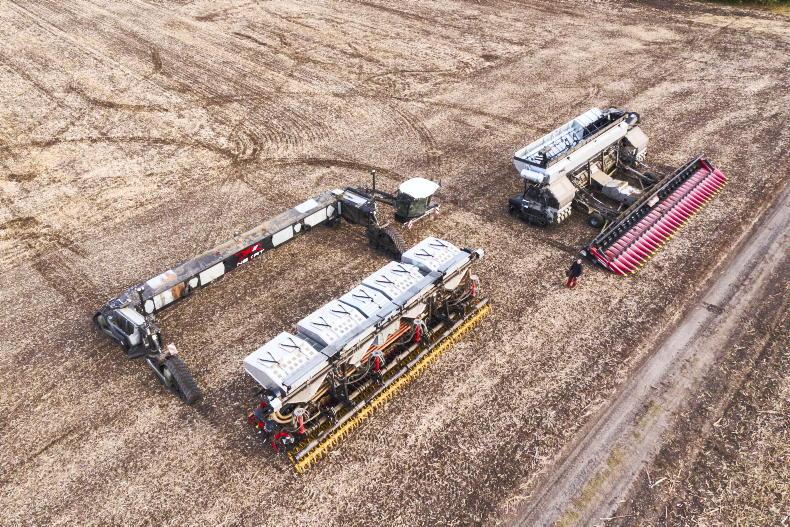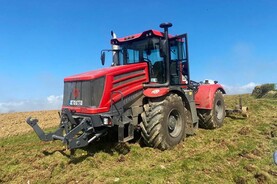Ahead of the biennial Agritechnica show in Germany, the German Agricultural Society (DLG) hosts an international innovation awards competition for the agricultural engineering sector.
This year, 164 new innovations were entered into the competition, from which 16 innovations took home silver awards, while only one took home gold.
Taking gold was the gantry type carrier vehicle from German company Next Generation Agricultural Technology (Nexat).
The company, since it was founded in 2017 by Kalverkamp Innovation, claims its dedication to the development, manufacture and sale of new plant production processes.
Crop production
The tool carrier can be used for all types of crop production work, including cultivation, drilling, spraying and harvesting. The difference over a conventional tractor is that implements are carried instead of being pulled.

The Nexat in front of a drill module (left) and combine module (right).
Working width ranges from 6m to 24m, with both manual and autonomous driving capabilities. The firm claims that this leads to increased efficiency.
With the 14m version, the system is designed such that 95% of the total field area is never driven on in the envisaged bedding mode, thus reducing soil compaction.
Features and running gear
It features a cab that rotates through 270 degrees for monitoring purposes so that it can be driven on the road. Implements are mounted between the four large, electrically-driven track units, which can rotate 90 degrees for transport.

The Nexat tool carrier fitted with a 70m Dammann sprayer module.
At present, power is supplied via two independent diesel engines, each producing 545hp, with generators to power the track units. The manufacturer has said that the vehicle has been designed for alternative drive technologies such as hydrogen in the future.
With the integrated NexCo 14m-wide combine harvester module, the Nexat achieves grain throughputs of 130t/h to 200t/h. Thrashing takes place via a 5.8m-long axial rotor mounted transverse to the direction of travel.
Energy efficiency
The flow of harvested material is introduced centrally into the rotor and at a tangent to achieve energy efficiency.
The rotor divides it into two material flows, enabling twice the threshing performance of a conventional combine.
A large 32m3 grain tank removes the need for side filling on the move, instead unloading can take place at the headlands. With an unloading capacity of 600l/sec, a full tank is said to unload in as fast as one minute.
Ahead of the biennial Agritechnica show in Germany, the German Agricultural Society (DLG) hosts an international innovation awards competition for the agricultural engineering sector.
This year, 164 new innovations were entered into the competition, from which 16 innovations took home silver awards, while only one took home gold.
Taking gold was the gantry type carrier vehicle from German company Next Generation Agricultural Technology (Nexat).
The company, since it was founded in 2017 by Kalverkamp Innovation, claims its dedication to the development, manufacture and sale of new plant production processes.
Crop production
The tool carrier can be used for all types of crop production work, including cultivation, drilling, spraying and harvesting. The difference over a conventional tractor is that implements are carried instead of being pulled.

The Nexat in front of a drill module (left) and combine module (right).
Working width ranges from 6m to 24m, with both manual and autonomous driving capabilities. The firm claims that this leads to increased efficiency.
With the 14m version, the system is designed such that 95% of the total field area is never driven on in the envisaged bedding mode, thus reducing soil compaction.
Features and running gear
It features a cab that rotates through 270 degrees for monitoring purposes so that it can be driven on the road. Implements are mounted between the four large, electrically-driven track units, which can rotate 90 degrees for transport.

The Nexat tool carrier fitted with a 70m Dammann sprayer module.
At present, power is supplied via two independent diesel engines, each producing 545hp, with generators to power the track units. The manufacturer has said that the vehicle has been designed for alternative drive technologies such as hydrogen in the future.
With the integrated NexCo 14m-wide combine harvester module, the Nexat achieves grain throughputs of 130t/h to 200t/h. Thrashing takes place via a 5.8m-long axial rotor mounted transverse to the direction of travel.
Energy efficiency
The flow of harvested material is introduced centrally into the rotor and at a tangent to achieve energy efficiency.
The rotor divides it into two material flows, enabling twice the threshing performance of a conventional combine.
A large 32m3 grain tank removes the need for side filling on the move, instead unloading can take place at the headlands. With an unloading capacity of 600l/sec, a full tank is said to unload in as fast as one minute.








 This is a subscriber-only article
This is a subscriber-only article










SHARING OPTIONS: